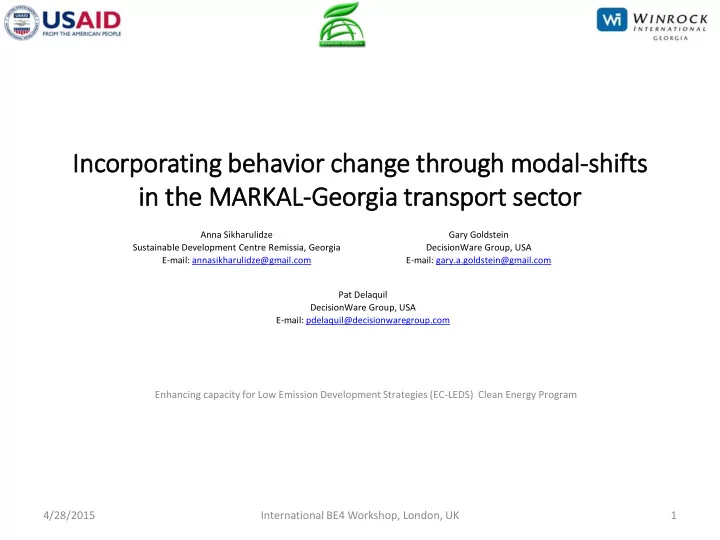

In Incorporatin ing behavio ior change th through modal-shif ifts in in th the MARKA KAL-Georgia ia tr transport se sector Anna Sikharulidze Gary Goldstein Sustainable Development Centre Remissia, Georgia DecisionWare Group, USA E-mail: annasikharulidze@gmail.com E-mail: gary.a.goldstein@gmail.com Pat Delaquil DecisionWare Group, USA E-mail: pdelaquil@decisionwaregroup.com Enhancing capacity for Low Emission Development Strategies (EC-LEDS) Clean Energy Program 4/28/2015 International BE4 Workshop, London, UK 1
Content: • Context • Description transport sector in MARKAL- Georgia • Introducing mode-shifting technologies • Results and Conclusions MARKAL Mode Shift 2
Context • Several major initiatives connected with GHG mitigation are going on in Georgia: – Determination of Intended Nationally Determined Contribution (INDC) – Preparation of Low Emission Development Strategy (LEDS) – Sustainable Energy Action Plans (SEAPs) of major cities under EU’s Covenant of Mayors(CoM) initiative MARKAL Mode Shift 3
MARKAL-Georgia • Developed by Georgian experts with support from USAID under the RESMD and EC-LEDS Programs • Analytic Department of Ministry of Energy is taking the ownership of the model. • Is being used to support development of INDC, LEDS and SEAPs • Encompasses an entire energy system of Georgia • Includes a comprehensive set of technologies in all sectors, enabling the assessments of mitigation measures coming from energy efficiency, renewable energy or fuel switching • Lacks the capacity to model so called “soft measures” such as behavior-change programs that affect the demand, i.e. in transport sector. MARKAL Mode Shift 4
Transportation Sector Structure – Passengers Sector Fuels Vehicle/Technology Type Energy Service Demand Gasoline & Bio- 2-wheeler - Million pkm Two wheelers ethanol Cars Car - Million pkm Existing, new, advanced and hybrid CNG Mini-buses Minibus - Million pkm Existing, new, advanced and hybrid Diesel & Bio- diesel Buses Bus - Million pkm Existing, new, advanced and hybrid Electricity Rail passenger Rail - Million pkm Existing, new Air passenger Air - Million pkm Aviation fuel Existing, new MARKAL Mode Shift 5
Introducing mode-shifting Fuel Switching Techs Sector Fuels/Mats Vehicle/Technology Type Energy Service Demand Popularisation of Public Transit Cars Shift to bus MAT Existing, new, advanced and hybrid Creation of municipal transport Shift to walking MAT Walking/cycling Development/promoti on of cycling Car - Million pkm Shift to cycling MAT Development/promoti Buses for mode-shifting on of walking new, advanced and hybrid Shift to rail MAT Development of urban rail/tram Rail for mode-shifting Gasoline & Bio- new ethanol Buses CNG Bus - Million pkm Existing, new, advanced and hybrid Diesel & Bio- diesel Rail passenger Rail - Million pkm Existing, new Electricity MARKAL Mode Shift 6
Modeling mode-shifting in MARKAL/TIMES • Materials: – are required for buses, rail, walking or cycling end-use technologies that can satisfy the demand for LDV travel. – material flows are tracked in units of million passenger-km (pkm), making their use and cost calculations straightforward. • Example: 5 cities in Georgia plan to develop cycling infrastructure and promote cycling. They assume they will need 11.5 million USD to set initial infrastructure and then around 3.8 million USD (7.5USD per capita) to maintain 5% modal share of cycling*. Based on population numbers of these cities and their urban travel, the pkms that they can shift to cycling make 0.4% of total pkms in Georgia, i.e. 42 million pkms. Therefore investment cost is 11.8/42=0.27USD/pkm and fixed cost is 3.8/42=0.09 USD/pkm. • Technologies: – represent particular mode-shift measures that can be some behavioral-change initiatives such as information campaigns or other types of undertakings that influence modal shift in transport. – The investment (and/or fixed & variable) costs equal to the cost of measures (including infrastructure for something like bike paths or costs of behavior-change advertisement program). – They produces dummy mode-shifting material, which is bounded by the limit of pkms that particular measures can achieve. – Demand devices then take the material flow and either provide pkm (in the case of walking/biking) or result in new “buses” purchased that then provide LDV services. * Cost and share estimations are based on International Energy Agency (2009), Transport, Energy and CO2 – Moving Towards Sustainability, OECD Publishing, Paris. MARKAL Mode Shift 7
Increasing of bus load factor Information campaigns (and measures such as increased parking fees for cars) can result in higher level of use of existing buses. • Consumes no fuel • Has no investment cost • Can satisfy only some • percentage of total mode- shifted pkms MARKAL Mode Shift 8
Results – comparison of 30% CO2 reduction runs with and without modal-shift CO2 Emissions by Sector 40 30 kt CO2 20 Transport 10 Residential Power 0 Industry -10 Commercial Agriculture -20 -30 -40 2021 2024 2027 2030 2033 2036 • With modal shift more emissions are reduced in transport sector, reducing the pressure on other sectors and resulting in lower system cost. MARKAL Mode Shift 9
Results – comparison of 30% CO2 reduction runs with and without modal-shift Transport Emissions by End-use 20 10 Transport two wheelers kt CO2 0 Transport domestic shipping Transport domestic aviation -10 Transport buses Transport Mini-buses -20 Transport LDVs Transport LCVs -30 Transport HGVs -40 Net Reductions -50 2012 2015 2018 2021 2024 2027 2030 2033 2036 • The model invests in mode-shifting activities for cycling, walking and public transport, thus reducing emission from LDV. At the same time because more busses are needed there is an increase in their emissions, though with an overall decrease of emissions in transport sector. MARKAL Mode Shift 10
Conclusions • This approach enables mode-shifting measures to be included in least-cost optimization. • It can be easily tailored for other sectors to model other non-technology demand-changing activity. • It can serve as an alternative to the hurdle rate approach to modeling energy efficiency, by separately modeling the measures and policies for ‘forcing’ more energy efficient technologies into the mix, to more adequately depict the hidden costs associated with such measures in the model. MARKAL Mode Shift 11
THAN ANK K YOU MARKAL Mode Shift 12
Recommend
More recommend